This post may contain affiliate links. Please read my disclosure and privacy policy.
This Almond Milk recipe is an easy dairy-free alternative that tastes even better than the store-bought variety. All you need is 2 ingredients to get started!

Why You’ll Love It
It tastes amazing. Homemade almond milk tastes far superior when compared to store-bought almond milk, so be warned– you may never want to buy the prepared version again.
It’s easy to make. Just blend almonds and water together in a blender, then strain out the pulp. The entire process can be done in just 5 minutes, minus the time it takes to soak the almonds. (Soaking is optional, though!)
It’s made without preservatives or thickeners. Store-bought milks need to rely on preservatives for a long shelf life, and often add gums and thickeners to make the milk have a uniform consistency. When you make almond milk at home, you can skip those added ingredients.
It’s easy to customize. You can easily add extra flavor to this almond milk recipe, like vanilla or chocolate, depending on your preference. Check out my Vanilla Almond Milk and Chocolate Almond Milk variations, if you want extra guidance.
It’s gluten-free & dairy-free. For those who can’t tolerate cow’s milk, almond milk is an easy lactose-free option. You can use it in smoothies, soups, sauces, cereal, and more!
You can use the pulp, too. Not only will you have delicious almond milk to drink, but you can also use the leftover pulp to make Almond Pulp Hummus or Almond Pulp Brownies.
Ingredients You’ll Need
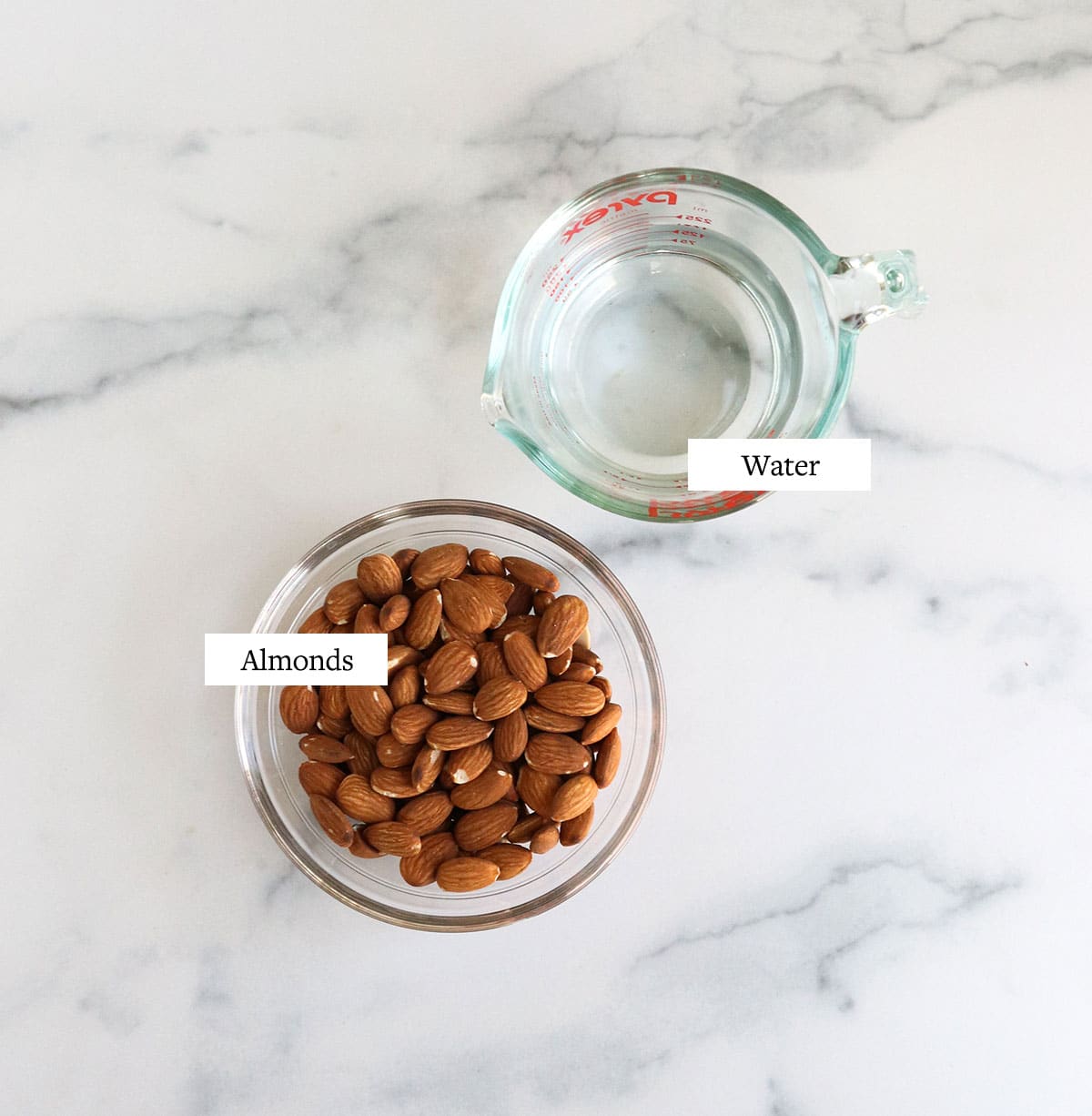
The only two ingredients you need to make almond milk are almonds and water. I tend to use almonds that are not roasted or salted, so the almond milk will have a neutral, mild flavor. However, roasted nuts will work, too!
If you want to make a flavored almond milk, you can also add in vanilla extract and a splash of maple syrup, for sweetness.
How to Make Almond Milk
1. Soak the almonds.
Research doesn’t necessarily support the idea that soaking nuts improves digestion or reduces anti-nutrients, but soaking almonds ahead of time can make them softer and help them break down in your blender easier.
If you want to take the time to do this step, cover the almonds with at least 2 inches of water, so they have room to expand as they soak. (I usually use 2 cups of water to cover 1 cup of almonds.) Let them soak for up to 8 hours, then drain away the soaking water by pouring the almonds into a fine mesh strainer.
You can skip this step if you already have a high-speed blender that can break down almonds effortlessly, or if you’re simply short on time!
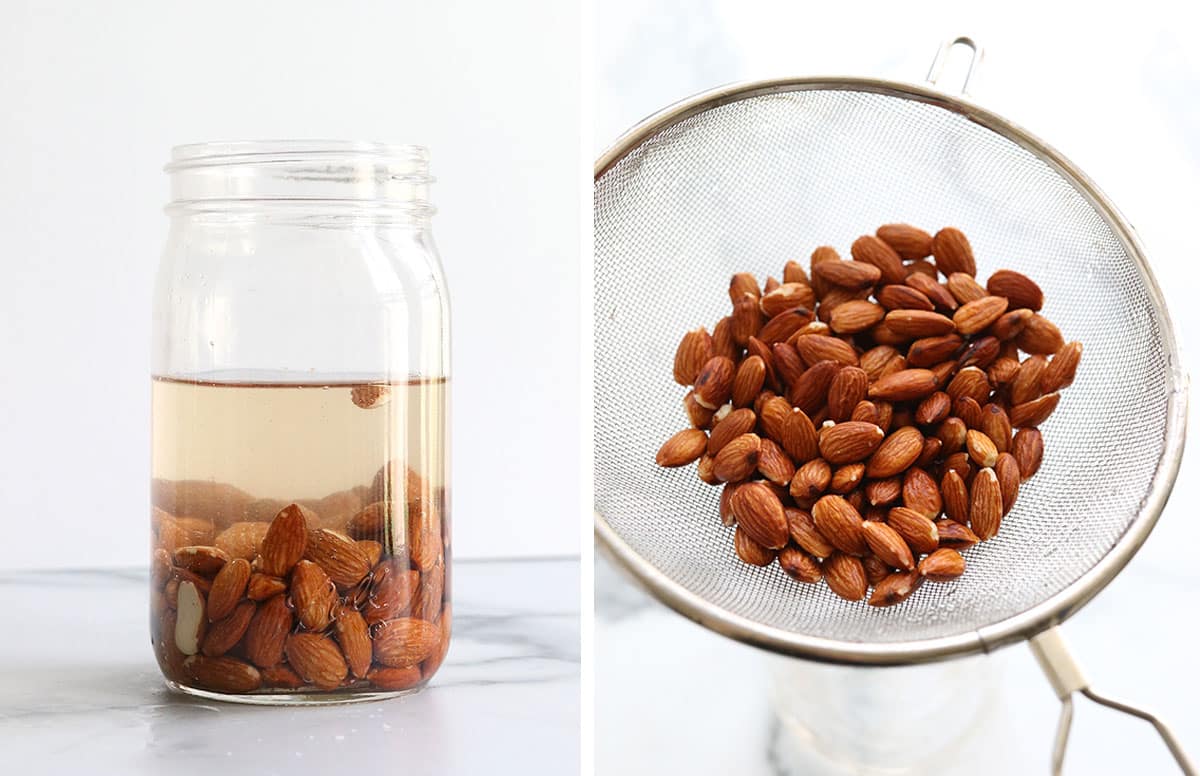
2. Blend.
Add the almonds into a high-speed blender, along with 4 cups of fresh water. Secure the blender’s lid and blend until the almonds are totally broken down and the mixture looks creamy, about 60 to 90 seconds.
There should be almost no visible almond pieces when it’s done blending.

3. Strain.
Arrange a nut milk bag or cheesecloth over a large bowl, then pour the blended almond mixture into the bag. Carefully squeeze the bag, removing as much liquid from the almond pulp as possible.
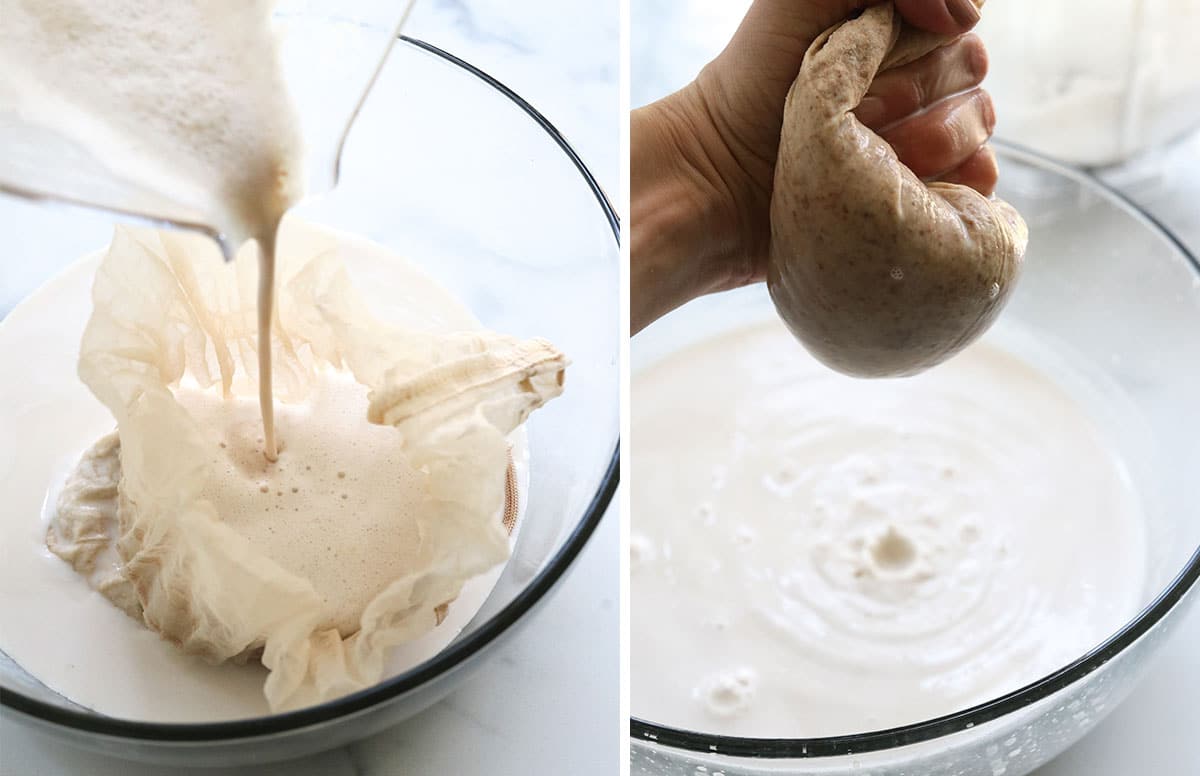
4. Enjoy!
You can use the almond milk right away, or add any extra flavorings to taste, such as vanilla, maple syrup, or a pinch of sea salt. Transfer the almond milk to an airtight container and store it in the fridge for up to 5 days. Or you can freeze it for up to 3 months.
Because this recipe doesn’t call for any preservatives, it won’t last as long as store-bought milks do. (You’ll be able to tell it’s gone off when the smell or flavor goes sour.) Be sure to make only what you’ll drink in a week, or plan on freezing the leftovers. You can easily scale the recipe as needed!
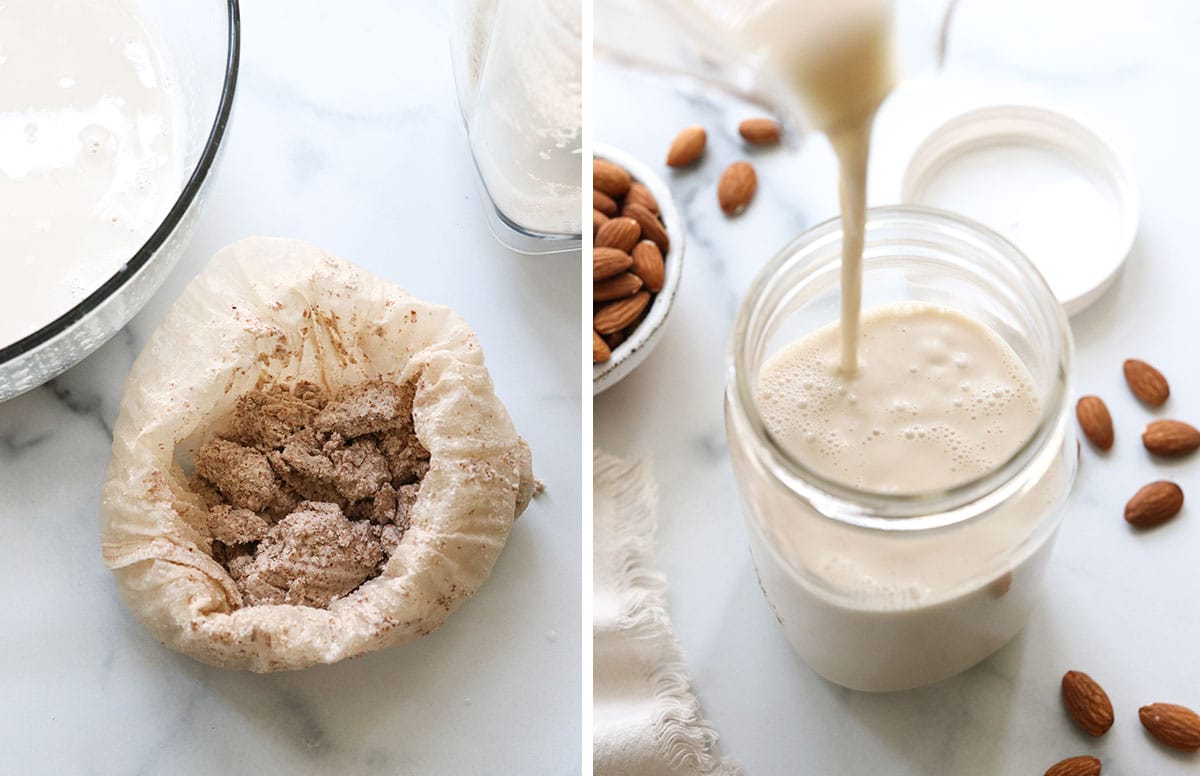
Frequently Asked Questions
Almonds contain important vitamins and minerals, like vitamin E and magnesium. Magnesium is involved in many processes in the body, including blood sugar control, so drinking almond milk may help you reach some of your nutrient needs. It’s also helpful if you are dealing with lactose intolerance, and need a dairy-free alternative.
Straining the almond milk is significantly more difficult when you add cocoa powder into the mix, so it’s best to strain the almond pulp before adding flavoring. This also keeps the almond pulp neutral-flavored, so you can use it in other recipes later (like hummus, which would not work with sweet almond pulp).
You can use the wet almond pulp immediately to make a batch of almond pulp hummus, or you can dry the almond pulp in a dehydrator or low-heat oven and save it to use a flour alternative. It’s not quite the same as almond meal, because some of the fat content has been removed, but it can also work similarly to oat flour in recipes.
Try using it in chia pudding, or over granola, or stirred into your morning oatmeal. It’s also can be frothed to make a foam for lattes, or use it in a chai latte or healthy hot chocolate.
Looking for more dairy-free milk ideas? You can make homemade oat milk for an affordable option, or try hemp milk for extra plant-based protein.
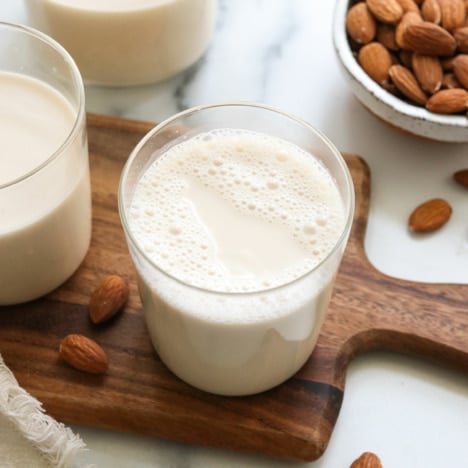
Ingredients
- 1 cup almonds
- 4 cups filtered water
Instructions
- To soak the almonds before blending, cover them with 2 cups of water in a large bowl or jar, and let them soak for 4 to 6 hours. This step is optional, but may help with blending later if you don't have a powerful blender. Drain the almonds through a fine mesh strainer before moving on to the next step.
- Add the almonds and 4 cups of fresh water to a blender. Secure the lid and blend on high-speed for at least 60 seconds, until no pieces of almonds are visible and the mixture looks creamy.
- Pour the almond milk through a nut-milk bag or cheese cloth, squeezing well to extract the milk. You can save the remaining almond pulp for another recipe (see the full post for ideas) or discard. If you would like to flavor the almond milk with vanilla or chocolate flavorings, this is the time to whisk in any additions.
- Store the almond milk in an airtight container in the fridge for up to 4 days. (You can freeze leftovers, if needed, for up to 3 months, too!)
Video
Notes
Nutrition
If you try this almond milk recipe, please leave a comment and star rating below letting me know how you like it!


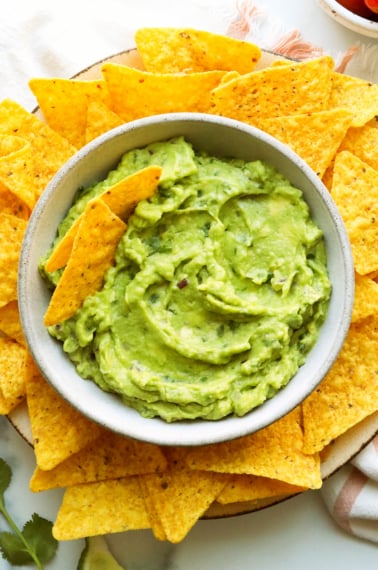
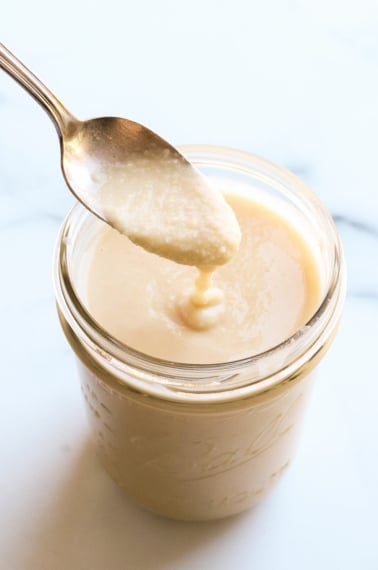
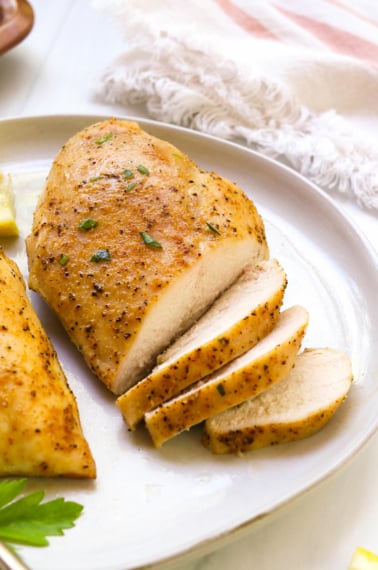







I love making my own almond milk, it tastes wonderful. However every recipe I’ve used seems to require soaking the almonds at least 4 hours, others saying 8 to 12…does not doing this change the consistency at all? Just wondering because it would be a HUGE time saver!
I haven’t noticed a difference in almond milk consistency, whether I soak my almonds for 4 or 12 hours. However, since I use a Vitamix, it would break them down easily, regardless!
The importance of soaking the almonds beforehand is to remove the enzyme inhibitors, which affect digestion, so I find 4 hours is sufficient for that, and rinsing really well before blending. Hope that helps! 🙂
Does soaking in water decrease phytic acid? Or would you need to add an acid to accomplish this?
If you are short on time, you can soak them for 2-4 hours using HOT water
How much coconut oil, sweetener and salt? It doesn’t say, and I can’t tell if it’s a 1/4 cup of 1/8 cup of coconut oil. Thanks so much!
Stupid question – what do you do with the leftover almonds that were in the bag? Can they be used in other recipes or do you just toss?
Not a stupid question! I have yet to find a “good” recipe for the leftover almond pulp, so I will often throw mine away… but I’m still trying to work on that!
I dehydrate mine and then grind it into almond flour with the dry grains container in the vitamix! It works *really* well as a filler in meatballs – or as a thickener for sauces.
Where did you get the bottle you use for the milk? I love it!
Thanks, I found the bottle at Home Goods!
I just made this and it tastes awesome!Definitely not the same as store bought, but worth it nonetheless to know there aren’t any extra chemicals/fillers. Also, the pulp makes great raw cookies with dates, cocoa, and nibs blended together. Yum!
Whoa, looks delish, I’m going to try it! After you make the milk – are the leftover, squeezed almonds worth saving? Could you use them in one of your other recipes or are they too pulsed for use?
I have yet to find a good recipe for the leftover almond pulp! I tried making cookies with it once, and they were a total flop. The texture is very bland and mushy, so it’s hard to create something tasty out of that! (However, I’m sure it can be done– I just haven’t had any luck yet!)
Let me know if you make anything good with it! 🙂
Do you think it would help (for baking) if the pulp was dehydrated before trying to use it for recipes?? I would love to know. I hate the idea of just throwing it out. Seems like some good health benefits could still be had from it, right?
I know that you were referring to a recipe to eat, but the leftover almond pulp makes an excellent homemade facial!! SpaIndex.com Guode to Spas http://www.spaindex.com/HomeSpa/AlmondScrub.htm my face feels beautiful after using it!!
Should I dehydrate and regrind first, or use wet for the facial? In our family of 5 we have three girls including me so there are lots of facials to be had and perfect for some quality girl time. Thanks for the tip!!
BTW- I’ve made this almond milk a few times now, and it is fantastic, and so easy in my Vitamix!! Next I want to try flavoring/sweetening it. I’m sure it will be delish!!
**If anyone wants to buy a nut-milk bag without spending a small fortune, you can buy a nylon mesh paint strainer bag in 1 gal size that has an elastic band at the top for about $1.37 each at Sherwin Williams Paint stores. I just bought a couple a weeks ago, and they work fantastic, treat them as you would any nut-milk bag.
I usually dehydrate first simply because there might be too much liquid in the mixture. I am so glad that you like it! My sister and I both love the facials on this website! (I am 13 so facials are always very nice
Hi, How nany calories are in a cup of almond milk using this recipe (1 cup almonds to 4 cups water)? You gave the nutritional info but it did not specify the serving size.
Thank you
The nutrition info is estimated for 1 cup, but keep in mind that it can’t calculate how much pulp is removed, so it’s a really rough estimate.
You can add the leftover almond pulp to a veggie/fruit smoothie to add extra fiber without changing the flavor.
You probably already know this by now, but dry the pulp in the oven, then make almond flour with it.
Couldn’t you use the pulp in anything just to add fiber? If the recipe has a good strong taste I would think it wouldn’t matter. Never mind I see someone suggested smoothie already… Sorry my brain doesn’t start until 4 pm PST. lol
Just mix the almond pulp with some coconut oil and use as an exfoliator, or dump it in your compost heap.
I dehydrate them in the oven and then season them to make fake Italian seasoned bread crumbs. Works great in meatballs.
temperature and length of time in oven?
thanks for this post. quick question- how do you clean your nutmilk bag?
I wash mine by hand in the sink, using warm soapy water and rinsing well, then hang to dry. Turning the bag inside-out helps clean out all the little bits and pieces, too!
Wow, I think you finally convinced me to make this myself. Time to order the nut bag.
Thanks
OK! you’ve convinced me to try this. I don’t have a vitamix yet, but I’m thinking since you strain it, I will get something good out of it…
Have you tried the Almond Milk from Pressed Juicery yet?. OMG – you have to try it! Total Nirvana. Or maybe don’t try it because you will want to order it all the time. I’ve been adding one to my order of greens delivery. They add dates, vanilla and sea salt. It’s funny how even the organic boxed kind tastes kinda lackluster….
I will also try the creamy dreamy shake next. have not used avocados for dessert yet either. thanks for the inspiration!
I make almond milk once a week for my daughter. I use it when baking as well. I, like some others, use about a half cup of almonds, some dates, water and a pinch of salt. Yummmm!